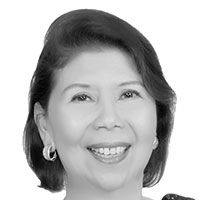The plight of the Filipino farmers

It breaks my heart to hear news about the plight of our farmers. Last week, news came out that their products had to compete with the ones imported from China. The same are the woes carried by our fishermen, poultry and hog raisers. Sanamagan! When will government ever get it right?
In 2006, my father, the late Maximo V. Soliven, was invited to speak at the “Farmers’ Night” forum sponsored by the Manila Overseas Press Club (MOPC). He quoted an important point that former Agriculture Secretary Domingo “Ding” Panganiban said, that the “greatest threat to food security and agricultural growth is the fact that the general public – our youth primarily – seems to have forgotten the relevance of agricultural development.”
Panganiban complained that it appears that “petty politics, advertising and shallow entertainment have become national priorities.” His talk could have angered the politicians and resulted in a denied operational budget of P16 billion at that time – not even enough to address the needs of the Agriculture Department.
Panganiban also pointed out that “farming is a weather dependent endeavor and the weather does not abide by the cycles of the fiscal year.” He sadly noted, “The budget is usually released during the wet season. By this time, not only is construction close to impossible but the critical moment when farm inputs are most needed would also have gone by.”
He added that he asked both the financial committees of Congress and the Development Budget Coordinating Council to “solve” this problem and that he was confident a resolution would be reached soon. Of course, my father reminded him, “A good farmer you may be, but the toils of the bureaucracy are not budged so easily even by the most earnest and optimistic.”
However, my father also quipped that hopefully, our leaders, politicians and decision-makers will someday wake up and answer the basic question: How can a nation feed its people if it does not strive to produce enough food?
By the way, Ding Panganiban, a graduate of the University of the Philippines, Los Baños, worked with my late father’s brother, Uncle Manny, under the late Agriculture Secretary Arturo “Bong” Tanco to formulate the Masagana 99 program by which the Philippines, for the first time and only a few years, became completely self-sufficient in rice. But as we all know, more than four decades have passed, and look at where we are now. We continue to have rice shortages, with the rice still being imported (some smuggled in) by the thousands of metric tons.
Masagana 99 was launched on May 21, 1973, after a series of natural disasters and pest infestations in 1972 caused a nationwide rice shortage. The program goals were to increase rice production from 40 to 99 cavans per hectare, farmers’ self-sufficiency and scale down rice importation. Agricultural experts were hired for the program, a credit scheme was created and technology packages were given to farmers, mostly high-yielding rice varieties and low-cost pesticides and fertilizers.
The program collapsed because of the following reasons. (1) Lack of properly-trained personnel. Agricultural experts and technicians that were supposed to help with the program were replaced with non-agriculturists. (2) Failure of farmers to repay loans. Rural banks shouldered the loans given to farmers. From 90 percent of the collection of repayment of loans, it became 35 percent in the latter part of the program, leading to severe consequences faced by the banks. It showed the lack of sustainability of the program. (3) Harm to the environment: The environment was damaged because of specific pesticides’ harmfulness. Crops, animals and farmers were put at risk.
There were several myths attached to the program. Myth #1: “During Masagana 99 in the early 70s, there was a very effective use of commercial banks, rural banks and even cooperative banks.” (Marcos, 2020) Debunked: According to Finance Secretary Carlos Dominguez III, 800 rural banks were bankrupted by that program and had to be rescued.
Myth # 2: It helped the farmers with production and income. Debunked: Masagana 99 failed to uplift the still-struggling farm sector. It left poor farmers highly indebted. Their non-repayment of loans also tarnished the balance sheets of many rural banks. Higher production and yields per hectare did not result in improved real incomes as the increased costs canceled whatever gains in production were achieved. Real farm wages (farm wage/consumer price index) started to decrease within the period when Masagana 99 was being implemented. From 1972 to 1977, real wages rose from P3.78 to P5.24. However, from 1977 to 1984, real farm wages declined by 46 percent [from P5.24 to P2.82].
Myth # 3: Masagana 99 improved the Philippine economy. Debunked: Even when the program was just starting, the country was also in debt for it. The United States Agency for International Development (USAID) initially funded the rice credit program with a P77.5-million loan. The World Bank was also part of the financing scheme.
Myth # 4: There was no corruption in Marcos’ programs. Debunked: Studies and news stories showed in detail how rural bank officials concocted “fake farmers” and “ghost borrowers” to siphon off millions of pesos intended for Masagana 99.
Myth # 5: Masagana 99 allowed the Philippines to efficiently export rice. Lack of context: “Volume of rice exported then was not consistent nor particularly high, save between 1979 to 1981.”
* * *
What about the Coco Levy Fund? The Coco Levy Fund is the taxation of farmers, with the promise of developing the coconut industry in the Philippines and a share of investments. It amounts to an estimate of P150 billion today, is said to be difficult to recover because the money has been split as an investment in different companies. The initial tax imposed was 55 centavos for the first domestic sale of every 100 kilos of copra.
It must be noted that 1/3 of the population relied on the coconut industry during the 1970s. Therefore, developing the industry was beneficial for all coconut farmers. But what went wrong?
Instead of following the promise of developing the coconut industry and giving the farmers their shares of investments, Marcos and his alleged cronies, Eduardo “Danding” Cojuangco, Jr. and Juan Ponce Enrile to name a few, used the funds to invest in businesses for their benefit.
Benefits collected were used to acquire two huge blocks of shares in the biggest food and beverage company – San Miguel Corporation. Other businesses purchased were the United Coconut Planters Bank (UCPB), Cocolife Insurance and oil mills.
Up to this day, farmers are still demanding the promised financial returns of the program.
Our country is rich in natural resources. We can actually enjoy God’s bounty for free. But until we choose the right leaders to steer us to the right path toward greatness, we will continue to suffer.
- Latest
- Trending





























